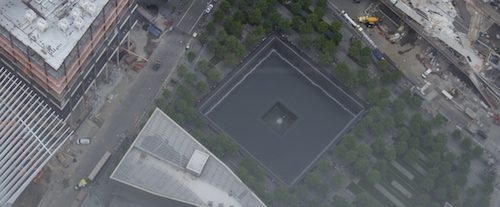Fri, 05/29/2015 - 19:20
Twin Towers are elephant in room at new World Trade Center
One World Trade Center opens to the public today, after years of planning, building, political squabbling and some four billion dollars in spending. The views are spectacular, naturally -- it’s the tallest tower in the Western hemisphere, and it rises above one of the world’s most mesmerising cities. On a clear day you can see for 50 miles (80 kilometres), taking in the Empire State Building, the Statue of Liberty and the Brooklyn Bridge.
But if you lean in against the window on the south side -- an unpleasant manoeuvre regardless of whether or not you suffer vertigo -- and look down, you can see another historic landmark: the foundations of the Twin Towers.

The South Pool, which lies in the foundations of the doomed South Tower, seen from the 100th floor of One World Trade Center. Photo © Sophie Pilgrim.
That’s not advised by organisers. During a two-hour press tour of the Observatory last week, there was no mention of the iconic towers that stood, until almost 14 years ago, just metres away.
“This is a forward-looking enterprise,” Chairman of the Observatory project, David Checketts, told reporters last week. “It’s a tribute to the hope of the future.” For those looking to commemorate the 9/11 attacks, Checketts said the 9/11 memorial and museum downstairs had been built specifically for that purpose.
The towers do make a three-second appearance in the lift, during a 500-year visual history of New York. Even there, developers considered leaving the buildings (which existed for 28 years), out of the video.
“The event is certainly a key part of history, we did not think you could ignore it,” Checketts told The New York Times in April.
But ignore it they did, save for those three seconds.
When asked what the Observatory was supposed to stand for, CEO of the company who built it, Dave Kerschner, talked at length about the “a global intersection for people from around the world” and “the many different ways people see New York”.
He was keen to boast that the company, Legends, had spent “enough money on making this experience something really special” (although the amount has not been disclosed). “That’s the show business side of things right there,” he said, almost winking.
In a cringe-worthy move, the building was made to reach 1,776 feet (1776 is the year of the American revolution, the building’s also known as “The Freedom Tower”). For the developers, it's a victory, a turning of the page after a shaky chapter in America’s history. Checketts has described it as a “fistpump”.
But once you’re in line with where the Twin Towers would have stood, it’s hard not to consider their absence. Metres away from the site where almost 3,000 people lost their lives in the most harrowing terrorist attack in history, this doesn’t feel like a place of pride, but one of pain.
Not for the developers. “It’s a brute fact. We did come back,” Checketts told ABC last year. “We built it even higher than it was before.”
Tickets to the One World Observatory are available from May 29 and priced between $32 and $90.
But if you lean in against the window on the south side -- an unpleasant manoeuvre regardless of whether or not you suffer vertigo -- and look down, you can see another historic landmark: the foundations of the Twin Towers.

The South Pool, which lies in the foundations of the doomed South Tower, seen from the 100th floor of One World Trade Center. Photo © Sophie Pilgrim.
That’s not advised by organisers. During a two-hour press tour of the Observatory last week, there was no mention of the iconic towers that stood, until almost 14 years ago, just metres away.
“This is a forward-looking enterprise,” Chairman of the Observatory project, David Checketts, told reporters last week. “It’s a tribute to the hope of the future.” For those looking to commemorate the 9/11 attacks, Checketts said the 9/11 memorial and museum downstairs had been built specifically for that purpose.
The towers do make a three-second appearance in the lift, during a 500-year visual history of New York. Even there, developers considered leaving the buildings (which existed for 28 years), out of the video.
“The event is certainly a key part of history, we did not think you could ignore it,” Checketts told The New York Times in April.
But ignore it they did, save for those three seconds.
When asked what the Observatory was supposed to stand for, CEO of the company who built it, Dave Kerschner, talked at length about the “a global intersection for people from around the world” and “the many different ways people see New York”.
He was keen to boast that the company, Legends, had spent “enough money on making this experience something really special” (although the amount has not been disclosed). “That’s the show business side of things right there,” he said, almost winking.
In a cringe-worthy move, the building was made to reach 1,776 feet (1776 is the year of the American revolution, the building’s also known as “The Freedom Tower”). For the developers, it's a victory, a turning of the page after a shaky chapter in America’s history. Checketts has described it as a “fistpump”.
But once you’re in line with where the Twin Towers would have stood, it’s hard not to consider their absence. Metres away from the site where almost 3,000 people lost their lives in the most harrowing terrorist attack in history, this doesn’t feel like a place of pride, but one of pain.
Not for the developers. “It’s a brute fact. We did come back,” Checketts told ABC last year. “We built it even higher than it was before.”
Tickets to the One World Observatory are available from May 29 and priced between $32 and $90.
Comments or opinions expressed on this blog are those of the individual contributors only, and do not necessarily represent the views of FRANCE 24. The content on this blog is provided on an "as-is" basis. FRANCE 24 is not liable for any damages whatsoever arising out of the content or use of this blog.



1 Comments
Post new comment